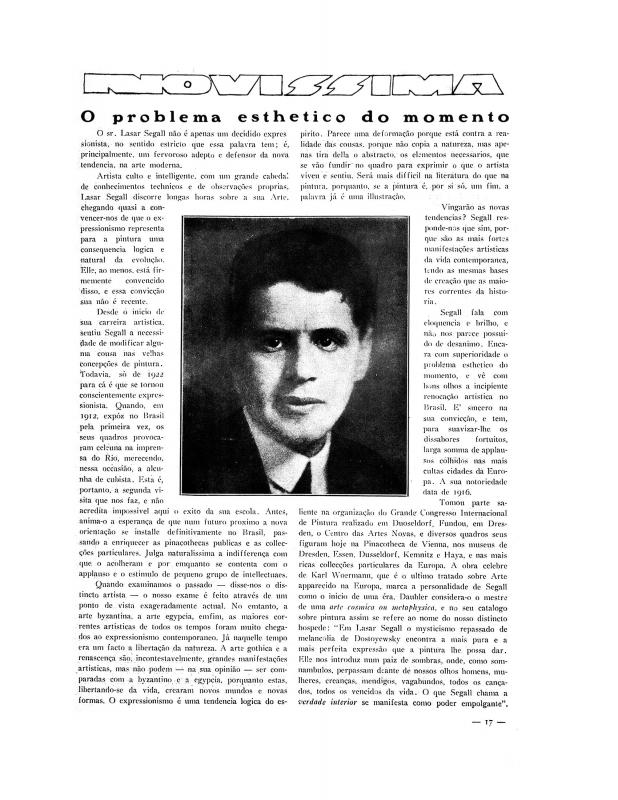In this essay, the writer and polymath Mário de Andrade (1893–1945) discusses the works that, in his opinion, best represent the artistic career of Lasar Segall. Among them was Eternos caminhantes (1918), one of the ten works by the Lithuanian-born (nationalized Brazilian) painter that were shown at the exhibition organized in Nazi Germany to discredit modern art, which was at that time considered “degenerate art” (Munich 1937). This canvas is from the artist’s “Brazilian phase,” and was painted between 1912, when Segall first visited Brazil and 1923, when he finally settled there.
Abílio Miller, on the other hand, offers what was perhaps the first critique of Segall’s work in “Um pintor das almas” [doc. no.1084988] during an exhibition held in São Paulo in 1913. The magazine Novíssima subsequently published (1923) an anonymous article about Segall’s second trip to Brazil and his aesthetic [doc. no. 781161]. In 1945, the Revista Acadêmica published an 82-page issue as a tribute in “número de homenagem a Lasar Segall” [doc. no. 1110322].
Lasar Segall (1891–1957) was born in Vilnius, Lithuania, where his family was part of the Jewish community. He enrolled in the School of Applied Arts in Berlin and, in the early years of the century, spent time at the Academy of Fine Arts. In 1912 he travelled to Brazil, where his brothers were already living. The Centro de Ciências e Artes de Campinas (SP) bought one of his paintings: Cabeça de menina russa (1908). He returned to Europe during the First World War. Joining forces with a group of German painters (such as Otto Dix) he co-founded the Dresdner Sezession – Gruppe 1919. After an exhibition of Russian art in Hanover in 1921 he established a relationship with Kandinsky. In 1923 he returned to Brazil. He painted a mural at the Pavilhão de Arte Moderna, a meeting place for artists and intellectuals at the home of the great promoter of the Semana de Arte Moderna of 1922, Mrs. Olivia Guedes Penteado. The mural was reviewed by Mário de Andrade, who identified his “Brazilian phase” (1924–28). Segall took part in SPAM’s Primeira Exposição de Arte Moderno and the Spamolândia project in 1934. Three of his paintings and seven prints were featured in the Entartete Kunst Ausstellungsführer [Exhibition of Degenerate Art] organized by the Nazis in 1937 to discredit modern art. In the 1940s he traveled, painted stage sets, and illustrated books and magazines. His major work, Navio de emigrantes (1939–41), was highly praised by George Grosz.
As regards the Spamolândia project that was promoted by the Sociedade Pró-Arte Moderna de São Paulo (1934), see [doc. no. 771325]. For more information on the founding of the SPAM group, whose statutes were introduced by the writer Mário de Andrade, see [doc. no 783393].





